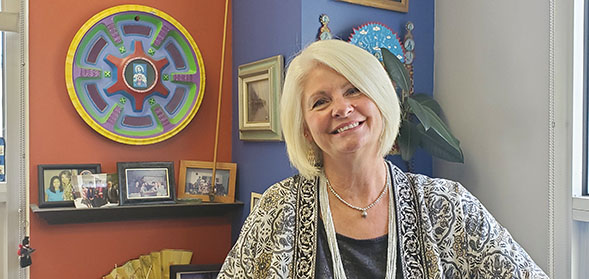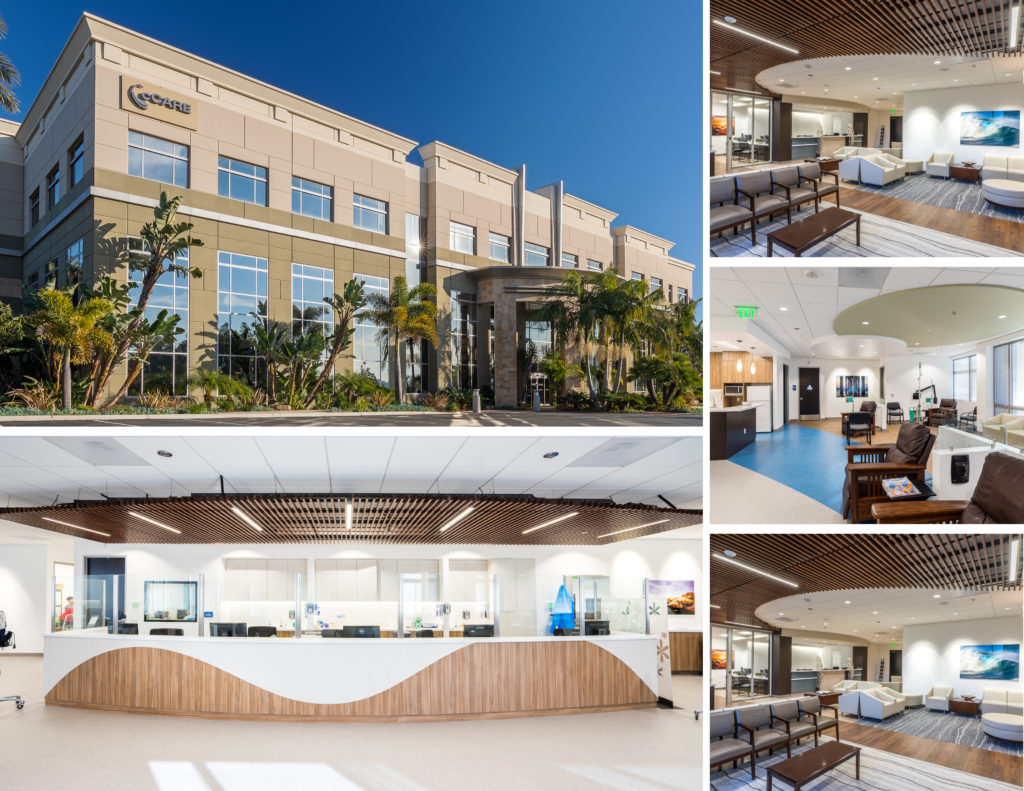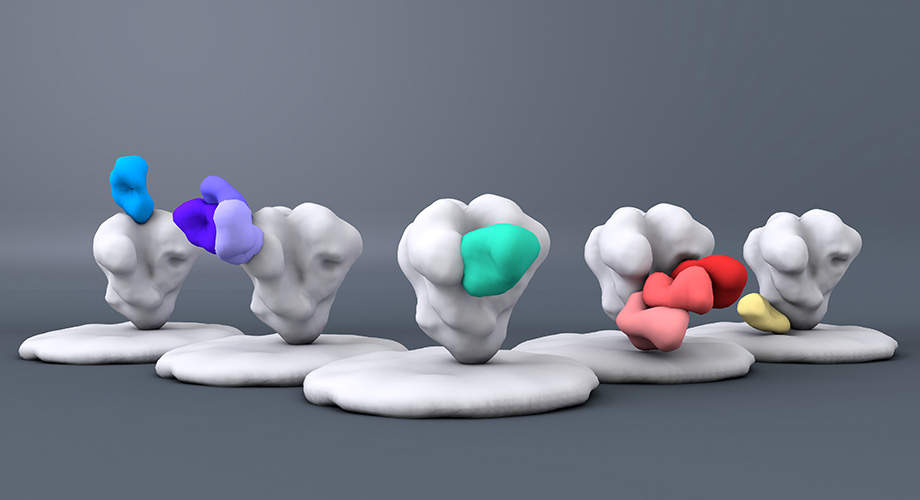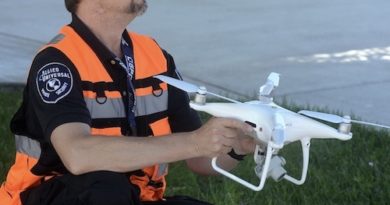Daily Business Report-July 16, 2019
This computer-generated graphic depicts immune system proteins called broadly neutralizing antibodies binding to different regions on the HIV Envelope protein on the surface of the virus (white). Antibody binding to the Envelope protein prevents the virus entering host cells and causing infection. (Illustration courtesy of Scripps Research Institute)
Scripps Research-led consortium receives
$129 million award for new HIV vaccines
The Scripps Consortium for HIV/AIDS Vaccine Development (CHAVD), an international collaboration led by Scripps Research, has received a $129 million award from the National Institutes of Health to advance next-generation vaccines designed to coax the immune system into producing antibodies capable of disarming numerous strains of HIV.
The seven-year award from NIH’s National Institute of Allergy and Infectious Diseases will support refinement and manufacture of novel HIV vaccine candidates so that they can move into early-stage human clinical testing. The candidate vaccine products are designed to be administered in multiple stages to induce immune system proteins called broadly neutralizing antibodies (bnAbs). In multiple animal studies, bnAbs have been shown to provide long-lasting protection against exposure to multiple HIV strains.
The award will fund the Scripps CHAVD comprised of 26 investigators: eight principal investigators at Scripps Research and 18 principal investigators at 13 other CHAVD-affiliated scientific organizations, including projects at four foreign sites
______________________

SDSU anthropologist elected
to national leadership role
By Padma Nagappan | SDSU
San Diego State University anthropologist Ramona Pérez in November will step into the role of president-elect/vice president of the American Anthropological Association (AAA) and assume the office of president at its 2021 meeting. Pérez, who spearheads key cultural programs at SDSU, will lead the largest association of anthropologists in the world, with more than 10,000 members.
Pérez obtained her undergraduate degree in anthropology at SDSU in 1992, then attended the University of California, Riverside for her master’s and Ph.D in cultural anthropology before joining the SDSU faculty in 2001.
She is also director of the Center for Latin American Studies, which provides students with opportunities to study abroad, participate in internships on both sides of the border, and enroll in joint graduate degree programs with other schools within SDSU. She is chair of Aztec Culture and Education, and spearheads all activities and projects for the Aztec identity initiative chaired by the SDSU president. In addition, she also chairs the university’s institutional review board which vets all research related to human subjects, from clinical trials to social surveys.
Pérez coordinates three language immersion programs – Nahuatl, Mixteco, and Zapoteco. Nahuatl is the language of the Nahua people who are descendants of the Aztecs and is the most widely spoken of all indigenous languages in Mexico. Mixteco and Zapoteco are the two dominant indigenous languages in Oaxaca, Mexico. The programs attract a wide range of language learners, from police officers to doctoral candidates. Pérez has been taking her students to Oaxaca for summer training since 2002.
______________________

Simons Foundation commits $20 million
in quest to understand universe’s beginnings
Scientists may come one step closer to understanding the conditions of the universe moments after its inception, thanks to a future commitment of $20 million made by the Simons Foundation. The funds will support the operations of the Simons Observatory, contingent upon the successful completion of the design and construction of the project. An official groundbreaking ceremony for the Simons Observatory was held on June 30 at the observatory site in Chile’s Atacama Desert (at 17,200 feet in elevation).
The project was made possible with $60 million in funding previously provided by the Simons Foundation. The additional $20 million in operations funding would be made over a span of five years, beginning in 2022.
A consortium of researchers, including astrophysicists from the University of California San Diego, will use the observatory to measure the cosmic microwave background (CMB) which provides a window to the physics of the earliest universe, the nature of dark energy, the properties of neutrinos and how gravity imposed structure on the universe.
______________________

Global Medical REIT acquires San Marcos
medical office building for $11.85 million
The Nordahl Medical Centre, a medical office condominium at 838 Nordahl Road in San Marcos, has sold for $11.85 million, to Global Medical REIT of Bethesda, Md. The seller was Carlsbad-based Newport National Corp.
The property is leased to California Cancer Associates For Research & Excellence (cCARE), the largest full-service, private oncology and hematology practice in California. cCARE leases the entire 3rd floor of the 57,333-square-foot medical office building known as Nordahl Medical Centre.
The building was originally constructed in 2009 and widely considered one of the highest quality medical office buildings in San Diego County. cCARE provides a variety of services at this location including medical oncology, chemotherapy, radiation oncology, imaging, pharmacy services and clinical trials.
Cushman & Wakefield represented the seller in the transaction.
______________________

Scientists develop technology
to improve feasibility of fusion reactors
Scientists at the DIII-D National Fusion Facility have taken a step toward advancing fusion energy to a practical reality with a technology that enables more effective cooling of fusion plasmas, reducing the risk of damage to the interior walls of fusion tokamaks ( an apparatus for producing controlled fusion reactions in hot plasma).
The development is known as a small angle slot (SAS) divertor. Described in an article published last week in the journal Nuclear Fusion, it takes a new approach for reducing the intensity of heat and particles that come into contact with the tokamak walls during operation.
“Advanced divertor solutions are critical to future fusion reactors because there are limits to the energy that plasma-facing components can absorb,” said General Atomics (GA) physicist Houyang Guo, who led the multi-institutional team that developed the SAS technology at DIII-D. “To make such reactors reliably operate for many years, we need ways to more efficiently dissipate heat for steady-state operation.”
DIII-D is the largest magnetic fusion research facility in the U.S. and is operated as a national user facility by GA for the U.S. Department of Energy Office of Science.
______________________
Cubic’s Trafficware to deliver central
transportation management system to Livermore
Cubic Corporationannounced that Trafficware, which operates within its Cubic Transportation Systemsbusiness division, was selected by the city of Livermore to deliver its ATMS Transportation Management System to manage traffic across the city. The agreement includes services to install as well as integrate existing and new intersection traffic controllers citywide.
Cubic’s Trafficware has more than 300 major ATMS installations with hardware and software products deployed at more than 50,000 intersections globally.
Agencies such as Palo Alto, Walnut Creek, Carlsbad, Fresno and Santa Clara County have chosen Trafficware’s software and hardware solutions to improve mobility for millions of travelers each day.
______________________
At Home Group opens new store
in San Diego — its 200th overall
At Home Group Inc. announced the opening of its 200th store, in San Diego, marking a major milestone as the company continues its growth and expansion plans across the country. This milestone comes after At Home’s recent expansion into California, where the home décor retailer currently operates two stores with the potential to grow to more than 80 stores.
The San Diego store is located at 12080 Carmel Mountain Road.



